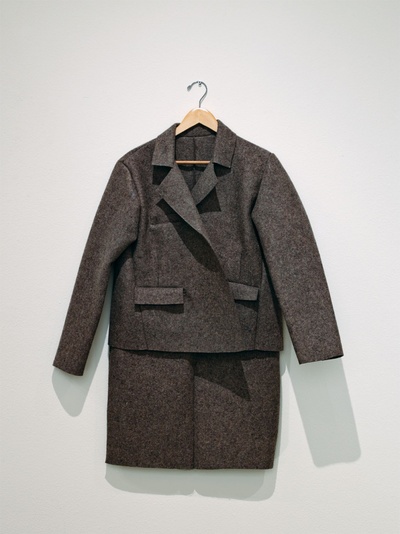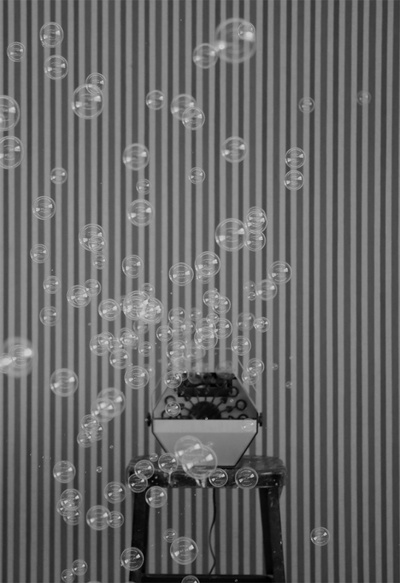Duets: Annette Lemieux
with Francine Koslow Miller
When on January 28, 2013, I made my first visit to Annette Lemieux’s spacious studio in Allston, Massachusetts, I was delighted and excited to see a museum-quality array of over a dozen paintings, sculptures, and photographic prints arranged on the walls, floor, and propped up on a variety of chairs and stools. Lemieux was working tirelessly to get everything readied, according to her strict and exacting standards, to be shipped to Aspen, Colorado for her show at the Baldwin Gallery, Annette Lemieux: Duets (Baldessari, Beuys, Chaplin, Duchamp, Evans, Guston, Man Ray, and Trockel) held February 15 through March 10, 2013.
I was immediately drawn to a color pigment print featuring the artist lying in her bed and puffing on a cigarette pursed between her lips. As if in a daze, she lies on a crisp white pillow and is covered up to her neck with a comforter upon which rests a plate piled with french fries. I guessed that the inspiration for Lemieux’s self-portrait was Philip Guston’s Painting, Smoking, Eating (1972), a canvas that depicts the wide-eyed protagonist trapped in an anxious, existential sleeplessness. Lemieux said that this funny/poignant image of her became the first work for her Duet series.

Annette Lemieux, Smoking Circle (after Baldessari),
2013, pigment print with gouache, 10 x 14¾”.
After carefully arranging herself with the props, Lemieux told me that she was photographed by her good friend, artist Shellburne Thurber. The result, Bad Habits (after Guston), 2013, is an apt example of Lemieux’s tongue-in-cheek self-effacing humor and empathetic engagement with the world. Pushpinned beside Bad Habits was the same image but modified by the addition of a large red tempera paint dot covering her face. This, I was told, was called Smoking Circle (after Baldessari), 2013, her double entendre duet with the California artist known for obliterating parts of his images with similar bright circles. Meticulously arranged on another wall were three felt suits—one made for a woman and two tiny suits designed for a young girl. Also notable was a group of very large, red-striped quadrangular canvases leaning on supports in advance of being assembled as a 12 x 11 foot installation based on the patterns of a barbershop in a vintage photograph by Walker Evans. The experience of talking with Lemieux in her studio about these and other notable works, both finished and in-process, made me very appreciative of her eccentric and enigmatic wit, conceptual feminism, meticulous craftsmanship, and reverence for art history.
After creating Bad Habits (after Guston) and Woman’s Felt Suit (after Beuys), 2013, Lemieux was mulling over a title for these works with Ingrid Pierre, her teaching assistant at Harvard (where she has been on the faculty in the Department of Visual and Environmental Studies since 1996). Pierre suggested Duets, a word referring to musical pairings, and Lemieux especially liked the word. Music always has been important for the artist who as early as 1984 painted the score of a German waltz on the top of a metal military helmet.

Annette Lemieux, Woman’s Felt Suit, 2013, wool felt with wood hanger, 43½ x 33 x 8″. Courtesy of the artist and Baldwin Gallery, Aspen, CO.
John Baldessari, Joseph Beuys, Charlie Chaplin, Marcel Duchamp, Walker Evans, Philip Guston, Man Ray, and Rosemarie Trockel all connect with her personal artistic mentality because of what Lemieux describes as, “the conceptual, the playful, the ‘why not’?” Woman’s Felt Suit, is Lemieux’s version of Joseph Beuys’s Felt Suit (1970), a multiple in an edition of 100, one of which the German artist once wore in Isolation, performed in Cologne in 1971. Lemieux hired a seamstress to make a gray suit to fit her body, and the product mimics the Beuys suit’s look, material, and even the sewn-in label bearing her name, gallery, and date of creation. However, instead of pants, her jacket is matched to a skirt—a conceptual feminist take on Beuys’s coded materials.

Annette Lemieux, Monte Carlo Bond Striped, 2013,
unique pigment print, 36¾ x 26½ x 1¼”.
Courtesy of the artist and Baldwin Gallery, Aspen CO.
Back in New York in the 1980s, Lemieux first became associated with the generation of artists connected with photographically scavenged images and clean-cut geometric art. Lemieux still relates much of her work to this initial association with the so-called “Pictures Generation.” “They were the generation before us, along with David Salle, Barbara Kruger, Sherrie Levine, Robert Longo, and Cindy Sherman,” she explained. “There was a zeitgeist in New York in the early ’80s when we new kids, including Ashley Bickerton, Peter Halley, Gretchen Bender, Jeff Koons, and many others were making similar work. I think we were all reacting to neo-expressionism and were being influenced by a second generation of conceptual artists, with John Baldessari at the helm.”

Annette Lemieux, The Canvas, 2013, pigment ink on
gessoed linen, 121⁄2 x 101⁄2 x 11⁄8″.
One may think that it might be difficult and isolating for any internationally recognized artist to remain in Boston since 1989. Boston’s quieter art scene does not seem to hold back Lemieux. She told me that she felt that, for artists today, “It doesn’t matter where we live, as we are all sitting somewhere in a white box making stuff.” Lemieux lives in Brookline with her husband, Erik Hansen. She doesn’t buy into any celebrity status, but thinks of herself simply as “Annette from Torrington, Connecticut.” Lemieux’s talent, candor, and utter dedication to making a significant statement in lovingly designed work makes her one of Boston’s artistic treasures.
All quotes by Annette Lemieux are from interviews with the author on January 28, and February 18, 2013. Annette Lemieux, Duets is her first commercial gallery show since her acclaimed retrospective, The Secret Life of Objects.
Francine Koslow Miller, Ph.D., is an art historian and writer based in Andover, MA.
